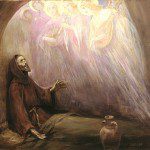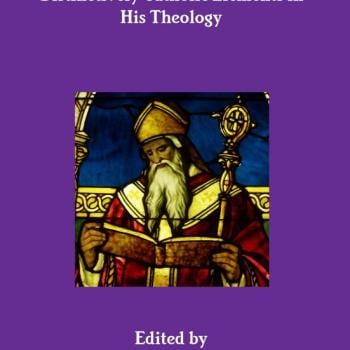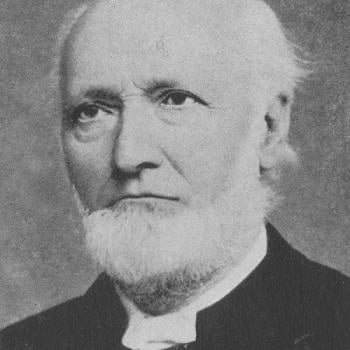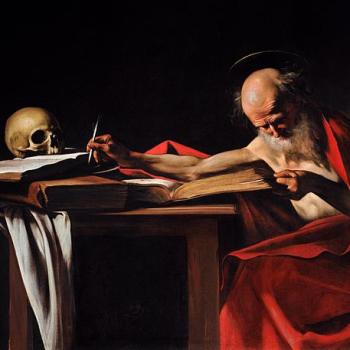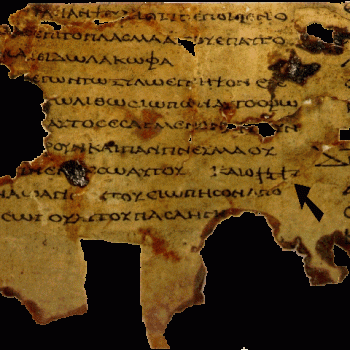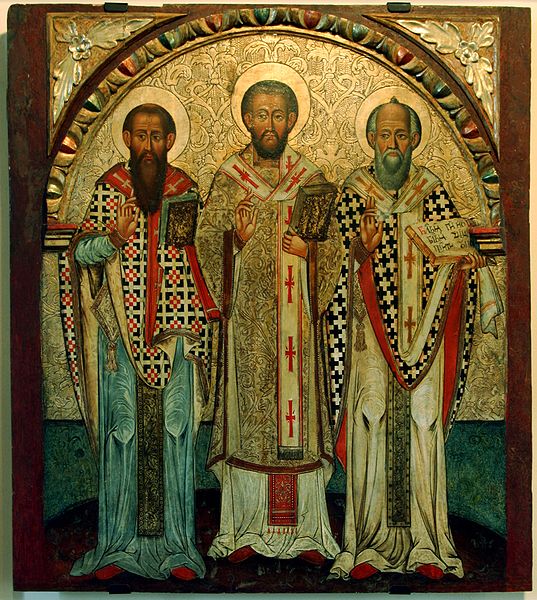
The Fathers of the Church: St. Basil of Caesarea, St. John Chrysostom, St. Gregorius of Nazianzus: 17th century icon from Lipie, Historic Museum in Sanok, Poland [public domain / Wikimedia Commons]
* * *
(1-16-01; rev. 5-7-03)
***
The fact remains that, according to historic Christianity, from the second century onwards (even according to historians who reject the concept, such as Philip Schaff and the Baptist Kenneth Scott Latourette), there is such a thing as an episcopacy (NT Gk. episkopos = bishop) and apostolic succession, as the prevailing mode of ecclesiology. One can’t possibly deny that. I can’t imagine any legitimate historian who would deny it.
Obviously, Baptists, Anabaptists, Churches of Christ, other non-denominational Protestant groups with congregational government, and suchlike, deny apostolic succession and episcopacy (in the historic and patristic sense of those terms), but that doesn’t undermine the fact that this institution existed very early on (I say from the beginning) and that it was well-attested by such early fathers as St. Clement, St. Ignatius, and St. Irenaeus.
The Encyclopedia Britannica (1985 ed., “episcopacy”), e.g., asserts (emphasis added):
. . . The origins of episcopacy are obscure, but by the 2nd century AD it was becoming established in the main centres of Christianity. It was closely tied to the idea of apostolic succession, the belief that bishops can trace their office in a direct, uninterrupted line back to the Apostles and Jesus . . .
During the Reformation in the 16th century, episcopacy was repudiated by many Protestant churches, partly on the grounds of its corruption but also because many believed the system was not based on the New Testament. The Roman Catholic, Eastern Orthodox, Anglican, Old Catholic, Swedish Lutheran, and some other churches have the episcopal form of church government . . .
Likewise, The Oxford Dictionary of the Christian Church (2nd ed., ed. Cross and Livingstone, Oxford Univ. Press, 1983, “Bishop,” p. 176) agrees (emphasis added):
. . . for St. Ignatius (early 2nd cent.), Bishops, Presbyters, and Deacons were already quite distinct . . . By the middle of the 2nd cent. all the leading centres of Christianity would appear to have had their Bishops, and from then until the Reformation, Christianity was everywhere organized on an episcopal basis.
As for apostolic succession, the same work states (p. 76, “Apostolic Succession”):
The fact of the succession of the ministry from the apostles, and of the apostles from Christ, was strongly emphasized by Clement of Rome before the end of the 1st cent.; and the necessity for it has been very widely taught within the historic Church.
How can we Catholics possibly accept such outrageous “late inventions”!? The late first century? That’s more than 267 years before someone (St. Athanasius) finally figured out the precise 27 books of the New Testament. Yet, for many Protestants, the NT canon is an unquestioned axiom, while historic episcopacy is an unbiblical outrage. It’s a strange world we live in.
In the same 2nd century which saw a rapid development of episcopacy (which even its enemies confirm), the NT canon was far from complete or known. Yet there was still this ethereal, necessarily tradition-bound thing called “Christianity,” operating quite well despite the impossibility of this “historical entity” of the 2nd century being grounded on any notion of sola Scriptura, as we know and love it today.
J. N. D. Kelly (Early Christian Doctrines, San Francisco: Harper, rev. 1978) confirms many of my arguments as well: he states that St. Ignatius “seems to suggest that the Roman church occupies a special position” (p. 191; section: “The Beginnings of Ecclesiology”). He generalizes:
What these early fathers were envisaging was almost always the empirical, visible society; they had little or no inkling of the distinction which was later to become important between a visible and an invisible Church . . . . For the fuller development of the theory of the invisible, pre-existent Church we have to look to Valentinian Gnosticism. (p. 191)
As to St. Irenaeus’ ecclesiological views:
. . . the identity of oral tradition with the original revelation is guaranteed by the unbroken succession of bishops in the great sees going back lineally to the apostles [Against Heresies, 3, 2, 2; 3, 3, 3; 3, 4, 1] . . . Indeed, the Church’s bishops are on his view Spirit-endowed men who have been vouchsafed ‘an infallible charism of truth’ (charisma veritatis certum) [ibid., 4,26,2; cf. 4,26,5]. (p. 37)
Historians, then, are virtually unanimous in asserting that the episcopacy was strongly in place by the mid-2nd century. Similar passages could be found in Latourette (Baptist), Schaff (German Reformed), and Pelikan (then Lutheran). I need not argue a “modern Roman concept” of a bishop in order for my point to be firmly established as one of historical record. Otherwise, my citations would be meaningless, as they all state the facts of history, obviously not from a partisan, “Roman” standpoint (as they are not Catholic). I could easily have argued from an Orthodox, or Anglican notion of a bishop.
Baptist theologian Augustus Strong railed against John Calvin himself (for his “objection to the identity of the presbyter and the bishop . . . on the ground of 1 Tim 5:17”). In his Systematic Theology (Westwood, New Jersey: Fleming H. Revell Co., 1907, rep. 1967, p. 915), Strong approvingly cites one Dexter and his book Congregationalism (p. 52):
Calvin was a natural aristocrat, not a man of the people like Luther . . . He believed in authority and loved to exercise it. He could easily have been a despot . . . He resolved church discipline into police control. He confessed that the eldership was an expedient to which he was driven by circumstances, though after creating it he naturally enough endeavored to procure Scriptural proof in its favor.
So once again, we find that honest disagreement leads to personal attacks and aspersions upon motives. Calvin was (we are told) a despot, and came to his ecclesiology based on expedience rather than biblical proof. This is a rare occasion when I can empathize with Calvin!
And this was a relatively minor dispute. Calvin was not exactly a flaming advocate of episcopacy! He begrudgingly acknowledged the historic episcopacy (including patriarchs and archbishops, synods and general councils), claiming that it was “connected with the maintenance of discipline” (Inst., IV, iv, 4). But of course he denies that this was a “hierarchy.” He does admit, however, that “the ancient bishops did not intend to fashion any other form of church rule than that which God has laid down in his Word.”
If the above scenario was the “intention” of these bishops, then it is certainly a form of government well in accord with that of Catholicism as I know and understand it (and far from both Baptist and present Reformed ecclesiology).
*****
Meta Description: Contrary to much Protestant opinion, bishops & the notion of apostolic succession appeared very early in the Church.
Meta Keywords: bishops, episcopal church government, ecclesiology, hierarchical church, Church authority, early Christian ecclesiology



